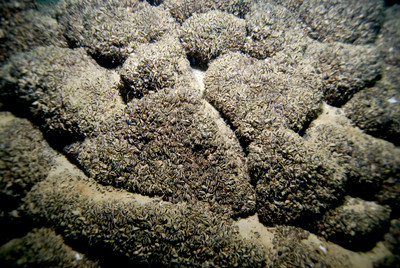Scientists report on explosive growth of invasive quagga mussels
Pesky quagga mussels that can clog water pipes and marine equipment at lakes Mead and Mohave are multiplying at an eye-popping rate.
They've produced dense colonies in a two-year span that rival those in the Great Lakes region, where they've been a nuisance for more than a decade, scientists said Tuesday at a Las Vegas conference.
In one part of Lake Mead upstream of Temple Bar, as many as 55,000 quaggas per square meter were found last year where none had been after they were first discovered in the lake in January 2007, said National Park Service biologist Bryan Moore.
In a presentation during the afternoon session of the Lake Mead Science Symposium at the University of Nevada, Las Vegas, Moore said that in the first few months after the initial discovery of quaggas in Boulder Basin, they numbered more than 500 per square meter. That's about what they've been in the Great Lakes, where they reproduce twice a year.
With the right mix of food, calcium, dissolved oxygen and water temperature, quaggas reproduce six times a year in lakes on the Lower Colorado River system, with a single female laying as many as 1 million eggs each time, scientists estimate.
Moore said scientists are monitoring 138 locations where quaggas have been found in Lake Mead National Recreation Area. In some cases, lesser numbers of quaggas have been documented at depths down to 300 feet.
He said the densest colonies occur at a depth of about 70 feet. Populations found in rocky areas are seven times greater than those in silty areas.
"At a lot of the sites there's no way to count the mussels. You'd run out of air," Moore said.
They have been found at Mead's Saddle Island intakes for the Southern Nevada Water Authority, which are at 60 feet and 110 feet below the lake's surface, said authority spokesman J.C. Davis. The intakes supply the Las Vegas Valley with 90 percent of its drinking water.
Warmer conditions and the more ideal habitat of lakes Mead and Mohave allow them to reproduce throughout the year, resulting in dense infestations where they can cling to flat surfaces including rocks, flood gates and water pipelines, the scientists found.
Federal and local water officials are concerned that systems for conveying water through lakes on the Lower Colorado River will face expensive maintenance problems while scientists search for ways to control the prolific population growth.
"They're here and I'm not sure we're going to get rid of them," Bureau of Reclamation Regional Director Lorri Gray said.
"We'll have to learn to live with them, and hopefully someday we'll learn how to get rid of them," she said.
Among the possible solutions scientists intend to explore are using dead bacteria to kill them and sterile black carp to eat them, Gray said.
Biologists also are concerned that quaggas, a zebra-type mussel that typically grow as big as a fingernail, will impact the lakes' ecosystems and sport fisheries by decreasing plankton, chlorophyll and oxygen that are vital to the aquatic food chain.
Back calculations by Moore's team indicate the first generation of quaggas was produced in Lake Mead in August 2005.
Biologists think quaggas arrived at Lake Mead by hitchhiking in bilge water or equipment of a boat from the Midwest that was launched in the lake.
Their discovery in Boulder Basin on Jan. 6, 2007, was the first known occurrence of the species in the Western United States.
Since then, they have been found in lakes Mohave and Havasu and in water systems in California.
Contact reporter Keith Rogers at krogers@reviewjournal.com or 702-383-0308.

















